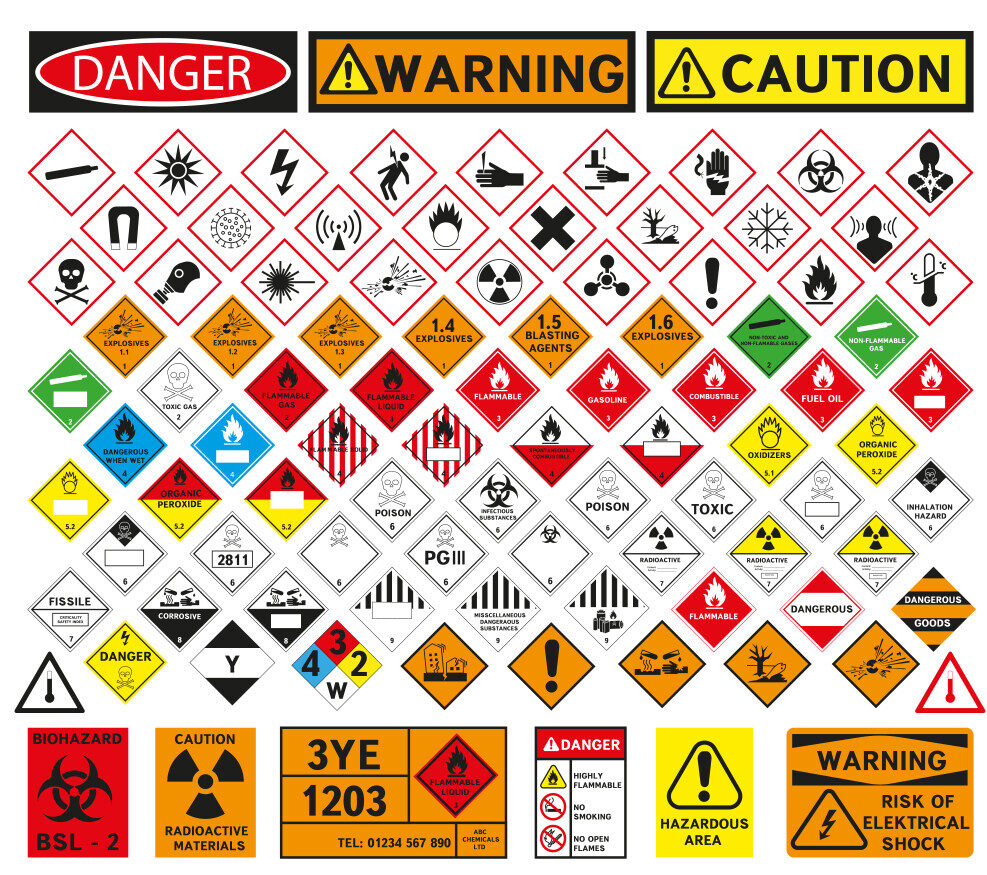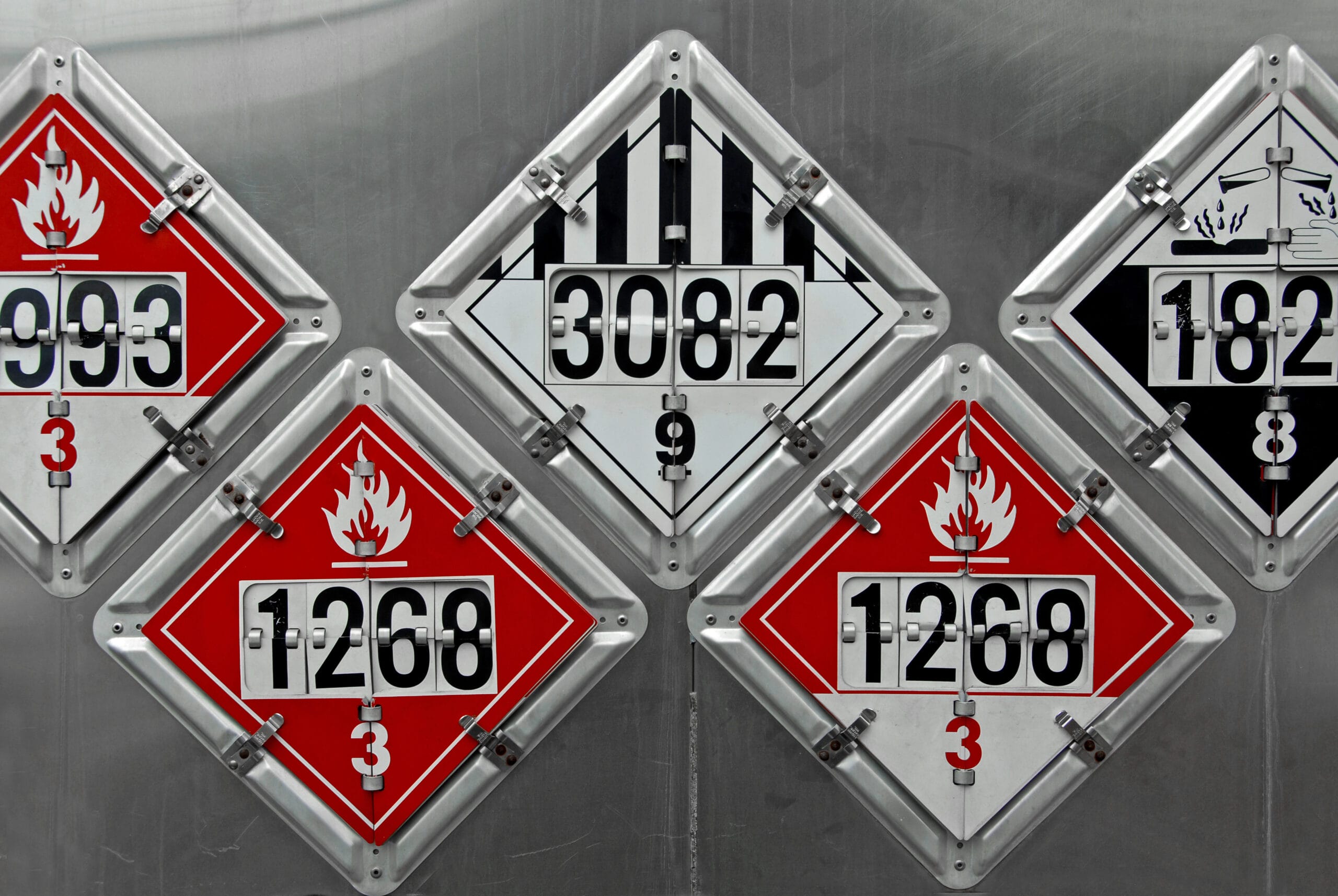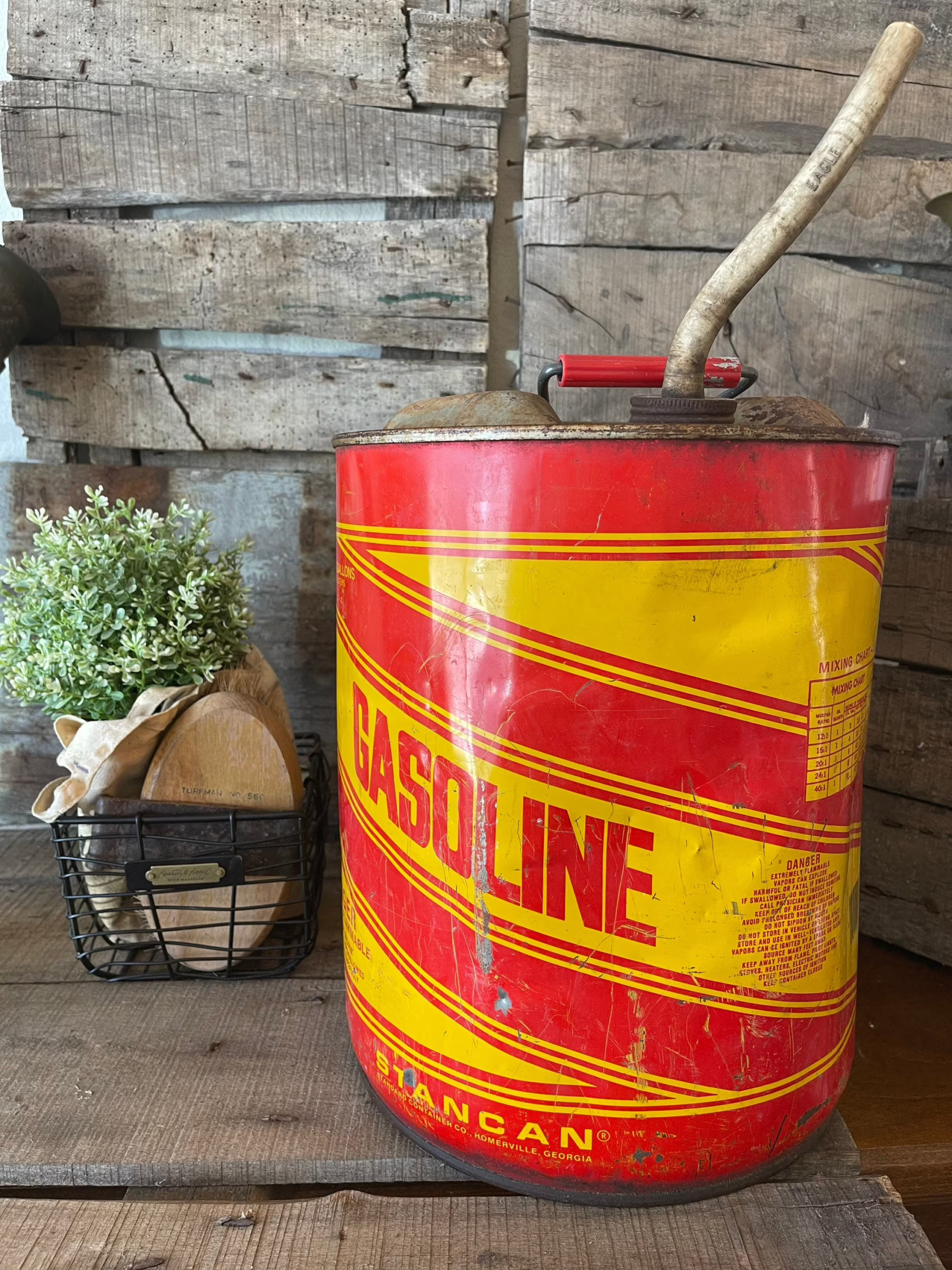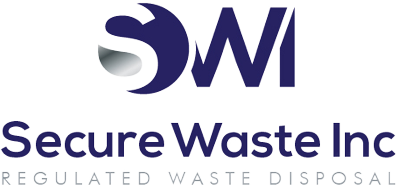Warning signs for hazardous materials: Essential information you should have from Secure Waste
Have you ever noticed those eye-catching diamond-shaped signs on the back or sides of semi-truck trailers and wondered what they mean? Those colorful HAZMAT placards play a crucial role in our everyday safety! They communicate essential information about the type of cargo the truck is transporting, which is especially important for hazardous materials.
The United States Department of Transportation (DOT) requires these signs to be displayed whenever hazardous materials are transported. Their importance is immense, serving as a lifeline for emergency responders in case of an accident. By informing them about the substances involved, these placards help ensure that safety measures are promptly and effectively taken.
Over two dozen unique truck placards represent various dangerous goods. The colors and symbols on these signs provide valuable insights into what the truck is carrying. By familiarizing yourself with these signs, you can enhance your awareness and contribute to a safer environment for everyone!
Speaking of safety, hazardous waste management in healthcare is an essential topic that we can’t overlook. At Secure Waste, we partner with healthcare clients to tackle the safe disposal of expired and excess hazardous waste, including expired pharmaceuticals, contaminated containers, and laboratory solvents.
Managing hazardous waste effectively safeguards both public health and the environment. Pharmaceuticals, for instance, are classified as hazardous waste if they meet specific criteria. Handling these substances responsibly can protect our communities and promote a cleaner, safer world!
Need Help With Hazardous Waste Management And Disposal? Contact Secure Waste Solutions Today

The HAZMAT sign consists of six major components (although not all signs contain each of these six parts)
- Hazard class number
- UN/NA number
- Compatibility letters
- Color
- Words
- Graphics
Class numbers:
The numbers 1 to 9 correspond to specific hazardous classes and their respective divisions, which are critical for identifying the type of hazards present. The class numbers are prominently displayed at the bottom of the sign, while the division numbers are indicated in the center.
Understanding these classifications is essential for properly handling, storing, and transporting hazardous materials. Each class represents a different type of risk, ranging from explosives and flammable materials to toxic substances and radioactive materials. The division numbers specify the particular characteristics or variations within each class, allowing for more precise identification and management of the associated dangers.
Class 1 — Explosives
1.1: Products with the potential to create a mass explosion
1.2: Products with the potential to create a projectile hazard
1.3: Products with the potential to create a fire or minor blast
1.4: Products with no significant risk of creating a blast
1.5: Products considered very insensitive that are used as blasting agents
1.6: Products considered extremely insensitive with no risk of creating a mass explosion
Class 2 — Gases
2.1: Flammable gases
2.2: Nonflammable gases
2.3: Toxic gases
Class 3 — Flammable and combustible liquids
Class 4 — Flammable materials
4.1: Flammable solids
4.2: Spontaneously combustible
4.3: Dangerous when wet
Class 5 — Oxidizer and organic peroxide
5.1: Oxidizing substances
5.2: Organic peroxides
Class 6 — Poisons
6.1: Toxic substances
6.2: Infectious substances
Class 7 — Radioactive
Class 8 — Corrosive
Class 9 — Miscellaneous
UN/NA numbers
Four-digit numbers classified as United Nations (UN), ranging from 0004 to 3534, are crucial in identifying and regulating hazardous international cargo transported throughout the United States. These identifiers are essential for ensuring safety and compliance during the shipping process, aiding first responders and transport personnel in swiftly assessing the nature of the cargo in case of an incident.
In contrast, goods not classified or regulated by the United Nations are assigned North American (NA) numbers. This set of four-digit identifiers ranges from 8000 to 9279 and is managed by the Department of Transportation (DOT). The NA numbers help regulate materials within North America that don’t fall under the strict hazardous classifications established by the UN.
UN and NA placards include a unique identifier that categorizes the cargo into specific classes and divisions, ensuring safe transportation. These identifiers also provide information regarding compatibility groups, assisting shippers in identifying the safe handling and storage of different materials. Effective use of these numbering systems facilitates compliance with safety regulations and enhances the safety of transporting hazardous materials.
Compatibility letters
On some signs, you may see the letters A-S. These compatibility letters help shippers and carriers know which explosives can be loaded together onto a trailer.
Hazmat Placard Identification: Colors, Words, and Graphics
Identifying hazardous materials (hazmat) placards can be straightforward when you know what to look for beyond just the class numbers. The colors, accompanying words, and graphics play a crucial role in conveying the nature of the materials being transported. Here’s a detailed breakdown:
Orange: The vibrant orange placard signals explosive materials, including dynamite, fireworks, and ammunition. These signs often feature a dramatic graphic representing an explosion alongside the number *1* to indicate their class. The warm hue instantly grabs attention, warning of the potential for sudden and violent reactions.
Red: Red signifies the presence of flammable goods such as gasoline, rubbing alcohol, paint, and acetone, which typically align with Classes 2 or 3. These placards are adorned with a striking flame graphic, demanding immediate recognition. They commonly display terms like “flammable,” “gasoline,” “combustible,” or “fuel oil,” alerting to the high risk of fire.
Green: A placard draped in green is reassuring. It indicates the transport of nonflammable substances, often compressed and liquefied gases. The sign boldly states “nonflammable gas,” accompanied by a graphic of a gas canister. It features the number *2*, symbolizing a lower risk profile than other colors.
Yellow: Yellow placards warn of oxidizers—substances that can ignite when mixed with oxygen and fall under Classes 2 or 5. These signs often depict a prominent “O” engulfed in flames and the word “oxidizer.” Everyday items like ammonium nitrate and nitric acid fall into this category, reminding handlers of the inherent risks.
White: A white placard signifies the presence of poisonous and biohazardous substances, including dyes, acids, aerosols, and medical waste. These signs typically use cautionary language such as “poison,” “PG III” (with PG denoting packing group), or “inhalation hazard,” and often feature a skull-and-crossbones image for toxic materials. For materials deemed biohazardous, the placard will state “infectious substance” with the biohazard symbol—three interlocking circles surrounding a central one—signifying serious health risks.
Blue: Blue conveys a sense of danger with goods that can become perilous when wet. This includes sodium, calcium, and potassium, which may ignite upon contact with water. The placards effectively use an image that warns of this peril, alongside a flame symbol and the number *4*, underscoring the urgent need for caution.
Red and White: A placard that’s half red and half white, marked with “spontaneously combustible” alongside a flame graphic and the number *4*, alerts you to materials that may ignite upon exposure to air. Substances such as aluminum and lithium alkyls are included in this category and pose a serious threat if not handled properly.
Red and White Stripes: Vertical stripes of red and white denote flammable solids like matches and magnesium. These placards are labeled “flammable solids” and exhibit a fire graphic, clearly communicating the risk of combustion.
Red and Yellow: The combination of red and yellow signifies organic peroxides, which fall under division 5.2 and are known for their ability to ignite or explode. Common examples include methyl ethyl ketone peroxide and benzoyl peroxide. The placards typically announce “organic peroxide” and may feature an “O” with flames or a classic fire graphic to convey the danger.
Yellow and White: Yellow and white placards indicate the transport of radioactive substances, often utilized in medical applications. These signs prominently display the word “radioactive,” accompanied by the radiation symbol—three blades surrounding a central circle—and the number 7, highlighting the profound implications of exposure.
White and Black: A placard split into half white and half black warns of corrosive materials capable of irritating or harming skin upon contact. This category includes batteries, hydrochloric acid, sulfuric acid, and sodium hydroxide. Clear labeling with “corrosive” is an image showing harmful substances spilling onto hands, and the number 8 serves as a crucial warning to all who encounter it.
White with Black Stripes: A white placard embellished with black vertical stripes at the top and the number *9* at the bottom signifies miscellaneous dangerous goods. This includes environmentally hazardous substances that do not fit neatly into other classifications, such as asbestos and dry ice, underscoring the need for careful handling.
By familiarizing yourself with these distinct colors, words, and graphics, you can enhance your safety and awareness of hazardous materials.
Inquiries you might have regarding hazmat placards and freight
Is it safe to drive near a truck carrying hazardous materials?
Driving near a truck transporting hazardous materials isn’t inherently dangerous, provided no accidents occur. Nevertheless, exercising caution is always wise; maintaining a safe distance and passing carefully when the opportunity arises is advisable. The Federal Motor Carrier Safety Administration (FMCSA) enforces stringent regulations that govern the safe transport of hazmat freight, prioritizing public safety on our roadways. These regulations mandate that carriers must:
- Conduct thorough safety inspections of their trucks before and during their trips to ensure everything is in optimal working condition.
- Steer clear of densely populated areas whenever feasible to minimize risk.
- Park their vehicles at least five feet away from roadways and maintain a distance of at least 300 feet from sensitive locations such as bridges, workplaces, tunnels, and residential areas (except during necessary operations that require brief stops).
Which hazmat class is the most dangerous?
Hazmat Class 1 is often deemed the most perilous among the various classes of hazardous materials, as it encompasses explosive substances. However, it’s crucial to recognize that all classes of dangerous materials pose risks that warrant careful consideration and vigilance.
Why are there multiple placards on a truck?
The Department of Transportation (DOT) mandates that carriers prominently display at least four placards in unobstructed locations, enhancing visibility to other road users. In addition to these standard markings, many carriers place two additional signs on either side of the truck cab for even greater awareness.
Can carriers transport multiple types of dangerous goods in one truck?
Yes, carriers can transport various hazardous materials within a single truck. When you see a car adorned with multiple colored placards, it signals the presence of more than one type or class of hazmat freight. However, strict restrictions accompany this practice to prevent adverse reactions between different categories of dangerous goods, ensuring safety throughout the journey.
Now that you have a more comprehensive understanding of the hazardous waste placards, don’t hesitate to contact Secure Waste.
We provide reliable, compliant, eco-friendly medical waste disposal solutions for your facility’s needs. We have expertise in biomedical, hazardous waste, and Sharps container disposal. In addition, we provide customized waste management plans, including secure collection and transport, and sustainable disposal practices.
Contact us today for a FREE Waste Assessment, or request a quote online!

Expert Medical Waste Management: With over 25 years of industry experience, Secure Waste is a trusted local leader in hazardous and biohazardous waste disposal across Maryland, Virginia, and Washington, D.C. Specializing in medical waste management, sharps needle disposal, and biohazard waste removal, the company ensures full compliance with federal, state, and local regulations while prioritizing environmental sustainability.
The company also offers additional services, including secure document shredding and sharps container sales, providing comprehensive solutions for healthcare facilities and businesses. Our cost-effective services help clients maintain regulatory compliance without unexpected costs.
With a commitment to customer satisfaction, Secure Waste offers tailored waste management plans that align with industry best practices. Their team of experts provides reliable, timely, and compliant services, making them the preferred choice for medical waste disposal. For a free waste quote or more information, visit www.securewaste.net






